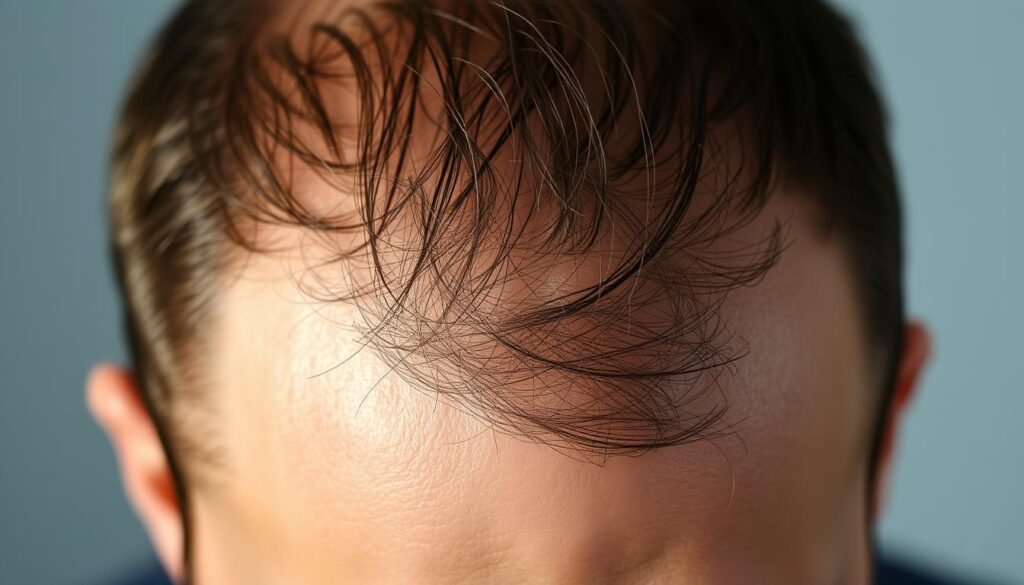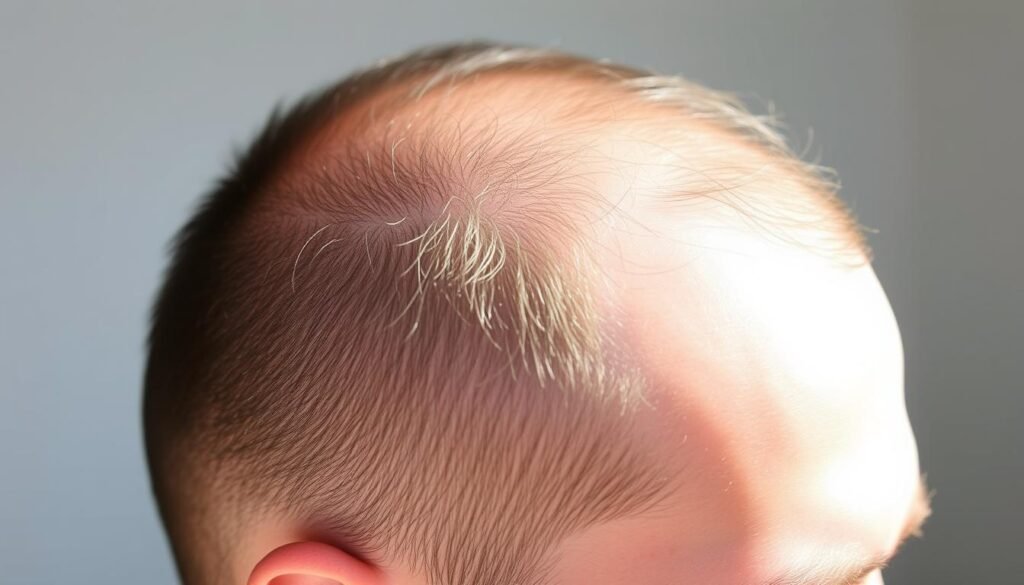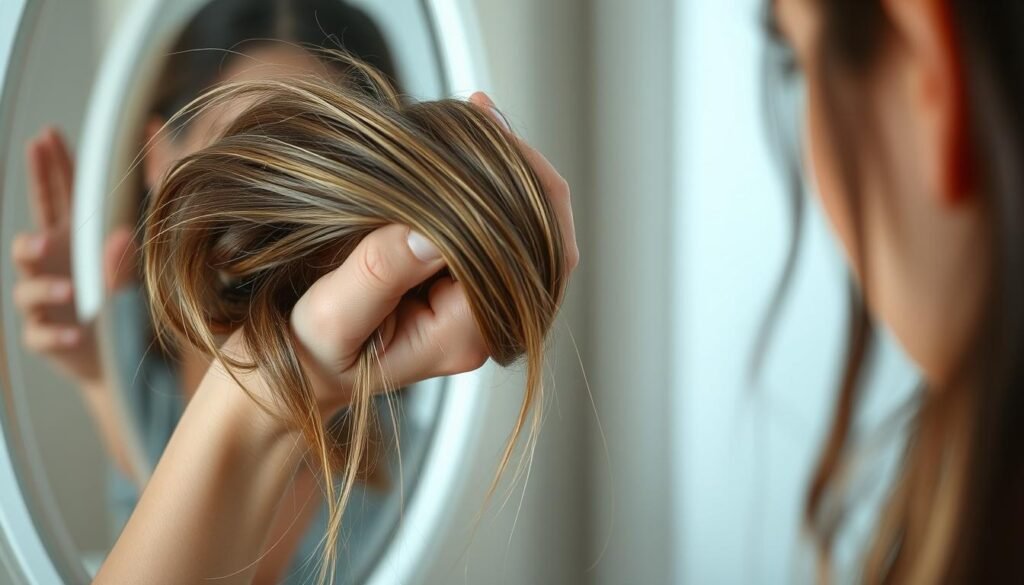About half of all men start losing hair by age 50. This problem can start even in the teen years. Both men and women need to know the early signs of losing hair. Catching these signs early is key. It lets people act fast to keep their hair. The main signs are a hairline that moves back and less hair on top.
Want more info? You can read about the signs of balding and what causes hair loss.
Key Takeaways
- Thinning hair can start as early as the teenage years.
- Common signs of balding include a receding hairline and thinning at the crown.
- Genetics play a significant role in the progression of hair loss.
- Hair loss in women typically presents as an overall thinning rather than a receding hairline.
- Early identification can lead to effective treatment options.
- Certain health conditions and hormonal changes may exacerbate hair loss.
Understanding Hair Loss
Hair loss, known as alopecia, can deeply affect how we feel about ourselves. It may happen on the scalp or the whole body. Some people might see their hair grow back, but for others, it’s permanent. Knowing about the various forms of hair loss is key to finding the right solution.
The Basics of Alopecia
Alopecia can happen for many reasons like genetics, hormonal shifts, and health issues. For example, a lot of men start to lose their hair in their 20s or 30s due to family history. Since there are many types of hair loss, each one needs a different approach to fix it.
Common Types of Hair Loss
It’s important to know the different kinds of hair loss to get the right help. Here’s a detailed overview:
| Type of Hair Loss | Description | Common Causes |
|---|---|---|
| Male Pattern Baldness | Gradual thinning primarily at the crown and temples. | Genetics, aging |
| Female Pattern Baldness | Diffuse thinning across the scalp. | Genetics, hormonal changes |
| Alopecia Areata | Patchy hair loss, can affect eyebrows and beard. | Autoimmune response |
| Traction Alopecia | Hair loss due to tight hairstyles. | Tight braids, ponytails |
| Telogen Effluvium | Temporary shedding often triggered by stress. | Stressful events, significant weight loss |
Knowing about these hair loss types helps us understand the reasons behind them. If we catch them early, we can manage better and keep our hair healthier longer.
Early Signs of Balding
Knowing the early signs of balding helps tackle hair loss sooner. Recognizing how thinning hair starts is key for early action. Spotting specific signs early on can shed light on balding possibilities.
Identifying Typical Patterns of Thinning Hair
Thinning hair usually starts at the temples or crown. You might notice less volume, leading to bald spots. Watching how much hair you lose daily is a clue. Losing over 50-100 strands could mean early balding.
Trying the hair pull test is another tip. If pulling gently removes over 10-15 hairs, it might point to major shedding.
Recognizing Receding Hairlines
A receding hairline often looks like an “M”. It shows hair loss at the scalp’s front and sides. The front hairline changing is usually the first sign.
Watching your hairline for changes is crucial. Over time, your scalp’s look might change, showing why it’s important to keep an eye on it.

| Sign of Balding | Description |
|---|---|
| Thinning Hair | Noticeable reduction in hair volume, especially at the crown or temples. |
| Receding Hairline | Formation of an “M” shape or visible recession at the forehead sides. |
| Excessive Shedding | Shed hair exceeding 100 strands a day or more than 10-15 hairs in a pull test. |
| Bald Patches | Localized areas of hair loss becoming apparent over time. |
Signs of Balding: What to Look For
Knowing the first signs of balding is key for early action. Observing changes in hair thinning can help shape your hair care plan. Recognizing these signs can make spotting balding easier.
Thinning at the Temples and Crown
Thinning at the temples and crown is a clear balding sign. These spots usually lose hair density first. When hair gets wet, the scalp may start to show more.
Changes in hair texture are also a clue to hair loss. So keep an eye on how your hair feels.
Widening Part Lines and Overall Hair Density Changes
A part line that gets wider might mean your hair is thinning. This is a hint that balding could be next. Over time, you might see your hair’s thickness change a lot.
Checking your scalp regularly can help catch hair issues early. Getting advice from experts is good for spotting serious problems. Learn more about hair loss at this link.

Factors Contributing to Hair Loss
Many factors can cause hair loss. It’s good to know these so you can care for your hair better. Genetics plays a huge role, especially androgenetic alopecia. This type of hair loss is common and often runs in families.
The Role of Genetics in Baldness
Genetics is a big reason why people lose hair. Androgenetic alopecia affects a lot of men. It makes hair follicles smaller, causing hair to thin. Research shows that family history is behind about 80% of male baldness cases. By the time they’re 50, up to half of all men might see signs.
Different parts of the world report different rates of this condition. For example, fewer Chinese men seem to be affected.
Impact of Hormonal Changes
Hormones also affect hair health. Changes like pregnancy or menopause can mess with your hair. PCOS is another condition where hormones lead to more hair loss. Healthy hormone levels matter, but genetic predisposition is key.
Importance of Nutrition and Health
Eating well is important for hair strength. If you don’t get enough protein or iron, you might lose more hair. Improving your diet can help fight hair loss. For more info on why hair falls out, check out this detailed guide.
When Should One Worry About Hair Shedding?
It’s essential to know when normal hair loss becomes a concern. Losing 50 to 100 hairs every day is okay. But, shedding more than that could mean a health issue. Keep track of hair loss to know when to see a doctor.
Understanding Normal Hair Loss vs Problematic Shedding
Hair loss changes with our lives. On average, 120 to 160 hairs can fall out daily. This is higher than what’s normal. Several factors play a role:
- Genetics, which impacts up to 50% of men and 70% of women as they age.
- Stress, which can lead to a lot of hair loss.
- Styling habits. Almost 40% of women see more hair fall due to heat styling and coloring.
If you’re worried about hair shedding, try the “pull test.” Pull gently on a bunch of 100 hairs. If less than 10 fall out, you’re likely fine.
Signs of Potential Health Issues
Sometimes, hair loss is just hair loss. But, other times, it can show health issues. Watch out for clues like:
- Sudden spots of baldness, which may mean alopecia areata.
- A slow thinning that isn’t typical for you.
- Losing hair all over your body needs a doctor’s look.
Anemia can also cause hair loss because iron keeps hair follicles healthy. Going for regular checks helps find any problems early. This way, you can get help sooner.

| Normal Hair Loss | Excessive Hair Shedding |
|---|---|
| 50-100 strands per day | More than 100 strands daily |
| Gradual thinning | Sudden or patchy loss |
| Stable hair density | Noticeable changes in scalp visibility |
| Healthy hair growth cycle | Disruption in growth phases |
| No additional health concerns | Associated health issues such as anemia |
Effective Methods to Monitor Hair Loss
It’s important to watch your hair health closely. This lets you act fast if problems show up. You can do simple things at home to keep an eye on hair loss. Doing self-checks regularly can help spot trends that need more looking into. Seeing a professional is key for a deep look into your hair’s health.
DIY Self-Checks for Hair Thinning
Self-checks are an easy way to check on hair loss. You can try different ways to notice any changes, like:
- Hair Pull Test: Gently pull a small section of hair. If you lose more than five to six hairs, it might mean shedding.
- Shedding Patterns: Note how much hair you lose each day. Losing 50 to 100 hairs is normal, but more than 70 might need a closer look.
- Tug Test: Pull gently on a hair section to check for breakage. If hair breaks easily, it could point to problems.
Professional Assessments by Dermatologists
Dermatologist visits provide a deep dive into hair loss issues. These experts can give special tests and insights. They commonly do:
- Scalp Examination: Looking at the scalp can show thinning or other issues.
- Trichoscopy: This looks closer at the hair and scalp for detailed analysis.
- Scalp Biopsy: Sometimes, a biopsy is needed to find the cause of hair loss.
Seeing a professional regularly is key to catching hair loss early. Being proactive can help you keep your hair healthy.
Treatment Options Available
Many solutions exist for those facing hair loss. You can find treatments over-the-counter or get them through prescriptions. They suit various levels of hair thinning and meet diverse needs. Each treatment has its own pros and cons to consider.
Over-the-Counter Medications and Topical Treatments
Early signs of balding can be managed with topical treatments. These products, including ingredients like biotin, zinc, and collagen, are found easily. Minoxidil (Rogaine®) is a popular choice, especially for men, and you don’t need a prescription. Other options like azelaic acid and tea tree oil help keep the scalp healthy, too.
Prescription Treatments and Advanced Procedures
For more severe hair loss, prescription meds are a key option. Finasteride (Propecia®) is an FDA-approved pick for men, targeting hormone-related hair loss. Corticosteroids are another option for quick and significant hair loss. Along with meds, there are surgeries like hair transplants and scalp reductions.
There are also high-tech, non-surgical methods. Platelet-rich plasma therapy and low-level laser therapy are among them. They encourage hair to grow. Combining these treatments can help people tailor a plan that fights balding effectively. There are many places to talk about these options, which helps in making the best choice. For info on hair loss diagnosis and treatment, visit this resource.
Preventive Measures to Consider
It’s crucial to take steps early on to prevent hair loss. Start by adopting healthy habits and changing your lifestyle as needed. Together, these actions will keep your hair looking great and reduce the chances of losing it.
Healthy Hair Care Routines
A good hair care routine is key. Here are some tips:
- Use gentle shampoos and avoid harsh chemical treatments to protect hair integrity.
- Incorporate regular scalp massages to enhance blood circulation.
- Limit heat styling and tight hairstyles to reduce stress on hair follicles.
- Opt for nourishing hair masks and deep conditioning treatments to keep the hair moisturized.
Following these steps will make your hair stronger and more able to stand up to daily challenges.
Lifestyle Changes to Minimize Risks
Small changes in how you live can have a big impact on your hair. Here’s what you can do:
- Maintain a balanced diet rich in proteins, vitamins, and minerals to support hair growth.
- Avoid smoking, as it adversely affects circulation and can expedite hair loss.
- Manage stress through mindfulness practices such as yoga or meditation, minimizing its negative effects on hair.
- Stay hydrated to ensure proper nutrient distribution throughout the body.
Making these changes will help keep your scalp healthy and lessen the chance of hair loss.
Conclusion
Knowing the early signs of balding is key for handling hair loss well. People should learn about different hair loss types, like male and female pattern baldness. They often start in the twenties and get worse as we age. Spotting these signs early helps people find the right treatments or ways to slow hair thinning.
Also, it’s important to know what causes hair loss. This could be genes or how we live our lives. Eating well, keeping hair healthy, and reducing stress are good steps. If hair seems to thin out quickly or without reason, seeing a doctor is a smart move. They can check if there are any health problems.
Having a plan for dealing with hair loss gives people control over their situation. Being informed and acting early really helps. It can change how hair loss affects us and keep our hair healthier for longer.